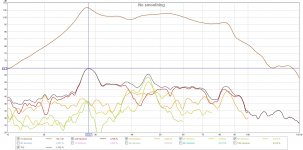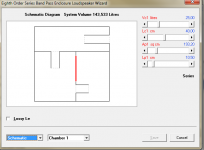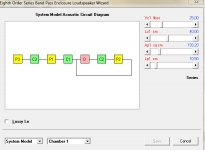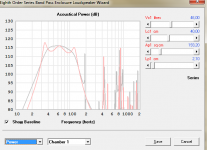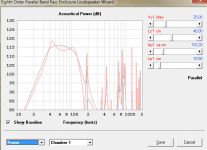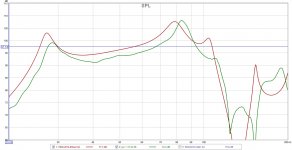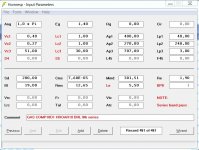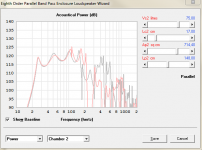AWESOME build! I like how the enclosure sits in the car
It is custom built for his car. It was a fun project and we are all happy with how it turned out.
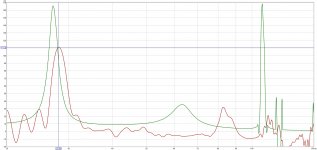
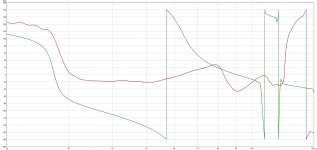
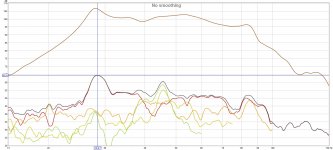
Some more measurements. GD and Phase is taken from the near port measurement I made indoors in my living room (picture of setup a few posts up)
Distortion is taken from the near windshield measurement I made in the car. I am impressed by the low amounts of distortion considering the nature of the driver. It is a pure spl-comp driver without any shorting rings on the pole piece of any other distortion lowering mechanism. The high order bandpass function really filters out a lot of distortion.
Both Phase and Group Delay is much better in real life then what Hornresp predicts.
Some might frown over the "excessive" GD, but it meant to be a spl-oriented car audio sub designed for a 20 year old basshead. A large GD will add a lot of tactile physical sense of overwhelming "power", and the car cabin adds even more GD which tends to overshadow whatever GD the speaker has from the beginning.
The most pronounced attribute of this build is its shear power and hard physical reproduction. Everything from the deep end rumble to the mid bass punch is felt like a hard physical and very tactile energy permeating your body. It is very far from the normal large air movement "panting" sensation of large bass reflex boxes and high Qts lowish Bl car audio drivers.
It makes your whole body tickle inside in a strange way. People used to large stacks of horns outdoors should know what I mean. This happens at a much lower Spl then I am used to, and becomes very overwhelming at high power levels.
We experienced the same odd behavior from the ROAR12 when compared to two large 18 inch bass reflex boxes. Everything inside the large warehouse where we tested the ROAR12 started to buzz and rattle at a much lower Spl from the ROAR12 then the two 18 inch BR boxes, despite the much lower cutoff (25 Hz) of the BR then the ROAR12 (40 Hz).
Serie BP 8th can now be done in hornresp !
Simming with my own driver parameters in picture 3, i tweak for curve like the grey one and not the red, phase and filtering wise. Really interesting topology.
It allow more damping as show in picture 4, compared to red curve of parralel 8th.
Thank Circlomanen for showing us this !
Simming with my own driver parameters in picture 3, i tweak for curve like the grey one and not the red, phase and filtering wise. Really interesting topology.
It allow more damping as show in picture 4, compared to red curve of parralel 8th.
Thank Circlomanen for showing us this !
Attachments
Really interesting topology! Thank Circlomanen for showing us this !
Well done !
Thanks!!!
I have been exploring series tuned quarter wave based 8th order BP for a few years now. ROAR and HROAR is the fruit of this work. Finally I have a much improved tool to simulate and explore them in the theoretical domain.
Thanks papasteak for asking David McBean for this feature in Hornresp!!!
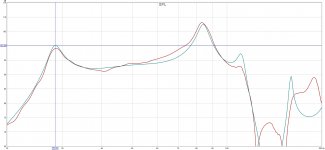
Increasing the Le and lowering the Bl slightly, and a more careful measurement of the actual length and cross section area of the HROAR10 gave this correlation between Hornresp and REW+Umik measurements.
You really can´t expect better correlation between sim and measurement then this.
Hornresp is truly a gift to all of us that love to build creative bass enclosures!
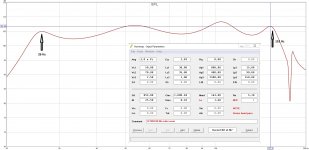
I have been playing around with this new series tuned 8th order BP function in Hornresp and I am impressed by the simulated response that is possible to get.
Here is a single B&C 15TBX100 in a 8th order BP. 26 - 152 Hz is almost 3 octaves of usable bandwidth!!!
Only 13 m/s port velocity at xmax for the driver. Much less from the large quarter wave front resonator.
View attachment 709847
This is one reasonable simple layout of a two driver version. Much more complex then the single driver version, but it gets a more symmetrical loading of the front chamber instead, which should be a good thing. Since there is only straight non expanding sections, it should be a very simple and fast build despite the increased number of parts.
No Hornresp sim of this layout at the moment. It is a work in progress and I am not done evaluating the first single driver version yet.
Are you thinking of a enclosure for 8" drivers or larger?
I have been simulating and sketching many different variations of the HROAR these last weeks. But I don't have the means to build any symmetrical dual driver HROAR at the moment. 8th order enclosures often become quite big for the chosen driver. I have become quite selective and fastidious when it comes to driver selection. Even though my GAS Alpha10D2 works perfectly fine in my HROAR, there is a whole other level of pure overwhelming brute power and impressive dynamics and punsch in low Qts and high Bl drivers like the GAS Comp12D or the Comp10D1 which we built with in the last car sub in this thread. I would guess that the same applies for drivers like the B&C 18IPAL or 15DS115 too.
I would love to get my hand on four of these drivers for a fun and reasonably capable home theater sub:
GZNW 38NEO-SPL – Ground Zero Audio
I can always simulate and sketch something if you have some drivers and want to build a HROAR. All the dual driver symmetrical layouts I have been simulating needs some measuring (REW) and DSP to flatten the spl response. The long section between the tapped pipe and the Helmholtz front resonator exaggerates the tapped pipe fundamental quarter wave resonance into a quite pronounced peak. See the response of the last build in this thread for an example of this.
Cheers,
Johannes
I would love to get my hand on four of these drivers for a fun and reasonably capable home theater sub:
GZNW 38NEO-SPL – Ground Zero Audio
I can always simulate and sketch something if you have some drivers and want to build a HROAR. All the dual driver symmetrical layouts I have been simulating needs some measuring (REW) and DSP to flatten the spl response. The long section between the tapped pipe and the Helmholtz front resonator exaggerates the tapped pipe fundamental quarter wave resonance into a quite pronounced peak. See the response of the last build in this thread for an example of this.
Cheers,
Johannes
I thought strokers were low Q drivers in the .2 family, but holy hell. Can those Q numbers even be real?
Well, they claim it has BL of 42.. if that's true then it is possible to have low Qes (and Qts).
Very strong motor there is!
Mms = 733grams, which is many times more than typical 15 inch woofers so it really needs lots of juice and heavy duty amplifier.
There are not too many PA/home amps capable for that (notice! 2x1ohm coils). Crest 10001 maybe? 10kW/2ohm bridged. Or Crown MA-10000.
I would love to have that woofer with 2x4ohm coils
Last edited:
GAS Competition 12D1 | GAS | Billjud | Brl.se
We built a TPCH with this driver and when I measured the response and compared it with Hornresp sims, I needed to increase Bl to get the spl curves to match reasonably well.
This indicated that the Qts (Qes) is lower in then the stated 0,20. It seems to have a Le of around 6.
It is a very powerful driver and combined with the hefty Mms it does have a unique and very addictive sound character of seemingly limitless abundance of power and raw physical tactile reproduction. Perfect for car audio and home theater, but a bit overwhelming for hifi.
High Bl and Mms, Low Qes drivers like these are a lot of fun. But they are a bit recalcitrant when it comes to designing a buildable box for them. Ample use of DSP is better then high compression rations and low cross section areas, or else the port velocity skyrockets very fast.
We built a TPCH with this driver and when I measured the response and compared it with Hornresp sims, I needed to increase Bl to get the spl curves to match reasonably well.
This indicated that the Qts (Qes) is lower in then the stated 0,20. It seems to have a Le of around 6.
It is a very powerful driver and combined with the hefty Mms it does have a unique and very addictive sound character of seemingly limitless abundance of power and raw physical tactile reproduction. Perfect for car audio and home theater, but a bit overwhelming for hifi.
High Bl and Mms, Low Qes drivers like these are a lot of fun. But they are a bit recalcitrant when it comes to designing a buildable box for them. Ample use of DSP is better then high compression rations and low cross section areas, or else the port velocity skyrockets very fast.
Viable element?
Would this element from Dayton Audio (Dayton Audio RSS210HO-4 8" Reference HO Subwoofer 4 Ohm) be viable for the HROAR or is the GAS element a better choice?
Would this element from Dayton Audio (Dayton Audio RSS210HO-4 8" Reference HO Subwoofer 4 Ohm) be viable for the HROAR or is the GAS element a better choice?
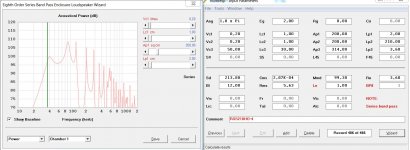
The Dayton Audio RSS210HO-4 seems to be reasonable suitable for a small compact HROAR-8 design. I have not made any drawing yet. This is just a first feasibility test in Hornresp, and I have not optimized it much.
Small drivers tend to get more pronounced peaks in the response graph, but this is not something I worry much about. DSP is cheap and room acoustics is usually much worse.
- Home
- Loudspeakers
- Subwoofers
- ROAR with Helmholtz front resonator
